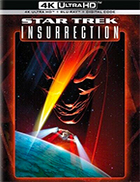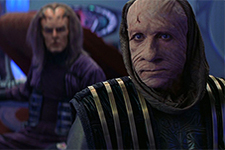| Director: Jonathan Fraker | | Screenplay: Michael Piller (story by Rick Berman & Michael Piller; based on Star Trek created by Gene Roddenberry) | | Stars: Patrick Stewart (Captain Jean-Luc Picard), Jonathan Frakes (Commander William T. Riker), Brent Spiner (Lt. Commander Data), LeVar Burton (Lt. Cmdr. Geordi La Forge), Michael Dorn (Lt. Cmdr. Worf), Gates McFadden (Dr. Beverly Crusher), Marina Sirtis (Commander Deanna Troi), F. Murray Abraham (Ru’afo), Donna Murphy (Anij), Anthony Zerbe (Vice-Adm. Dougherty), Gregg Henry (Gallatin) | | MPAA Rating: PG | | Year of Release: 1998 | | Country: U.S. |  |
|  Star Trek: Insurrection was the ninth installment in the Star Trek movie series and the third to feature The Next Generation cast originally introduced on television in 1986, but in many ways it is closer in spirit and tone to Gene Roddenberry’s original series than any of the other movies, with the exception of Star Trek VI: The Undiscovered Country (1991). Like the television series, Insurrection uses the genre of science fiction to address explicit social and moral questions, which is both the film’s strength and its weakness. On the plus side, it is certainly admirable that screenwriter Michael Piller (working from a story he concocted with fellow Next Generation scribe and producer Rick Berman) would stay true to Roddenberry’s spirit and use the film as a pretext for exploring important issues. The idea of science fiction as a forum for the expression of liberal consciousness is hardly new, but as sci-fi movies in the 1980s and ’90s were becoming more and more about special effects and spectacle than ideas and ideology, such a move was very nearly radical. On the negative side, the ideas are, not surprisingly, handled without a modicum of subtlety, with the most explicit messages being stated in sometimes ham-handed fashion by various characters making grand speeches. Again, this is really just par for the course; it’s not that Star Trek: Insurrection handles its ideological material badly, but rather than it replicates a little too closely the obviousness of the television series, which was forced to explicate its message in a brief 45 minutes. The movie ends up feeling, then, like an elongated TV episode. Much of the story takes place on the planet Ba’ku, where a colony of 600 people have been peaceably living for ... well, a very long time. It turns out that the radiation from the rings that surround Ba’ku have regenerative properties, in essence turning the entire planet into a fountain of youth. As complex societies are wont to do, the first inclination is to turn Ba’ku into a commodity, under the guise, of course, that it will be used for the beneficial purposes of healing and medicine. Thus, the Federation teams up with the Son’a, a race of humanoids who have been unsuccessfully trying to defeat the ravages of time with constant skin stretching, which has resulted in them looking more like mummies than the pride of youth. Captain Jean-Luc Picard (Patrick Stewart) and the rest of the Enterprise crew discover a secret plot to remove the inhabitants of Ba’ku so that the planet can be harvested for its regenerative powers, which will apparently destroy it in the process. Thus, Picard is faced with a moral quandary. He realizes that it is wrong to forcibly remove the planet’s inhabitants, especially since it goes against one of the Federation’s prime directives (the obvious allegorical implications here point to the U.S.’s forced removal of various Native American tribes from their lands throughout the 19th century). Yet, at the same time, the removal of the colony is by order of the Federation itself, thus to stop it Picard will have to lead an insurrection. Being the upstanding pillar of moral authority that he is, it isn’t surprising that Picard chooses moral right over bureaucratic decision making, but it is not without its consequences. Given its ideological implications, Star Trek: Insurrection contains more than its share of speechifying, some of which is admittedly powerful in its own way. In response to a Federation bureaucrat’s assertion that it’s “only 600 people” who are being moved, Picard’s piercing question about how many it takes before it’s wrong is a cogent and memorable summation of the ages-old quandary about balancing what’s right for a few with the needs of the many. Of course, when you step back and really think about it, it is fairly difficult to justify why the 600 Ba’ku shouldn’t move when it means great gains for the rest of the universe. The film attempts to sidestep some of these philosophical difficulties by casting the debate in black-and-white terms via the clearly self-interested Son’a and their “blood feud” against the Ba’ku, but it is a rather flimsy device that doesn’t hold up in the long run. The speechifying is balanced by a fair number of well-wrought action sequences, most of which are rendered with CGI that varies from excellent to almost embarrassingly cartoonish. Picard’s final showdown with Ru’afo (go-to baddie F. Murray Abraham), the Son’a’s embittered leader, is a suspenseful bit of action filmmaking, as is the chase sequence in which the Enterprise, led by Commander William T. Riker (Jonathan Frakes, who also directed), evades a pair of So’na ships. There is also a clear desire to sex up the Star Trek universe, as we are treated to not only a candle-lit bubble-bath scene with Riker and Commander Deanna Troi (Marina Sirtis), but also a burgeoning romance between Picard and a lovely resident of Ba’ku (Donna Murphy). (There is also a gag about the women of the Enterprise crew noting the planet’s regenerative effects on the perkiness of their breasts, which surely marks the first time the word boobs has been uttered in a Star Trek show.) Star Trek: Insurrection was not one of the more well-received films in the series, especially as it followed on the heels of the more action- and melodrama-oriented Star Trek: First Contact (1996). Nevertheless, it is a well-mounted production that is never dull, and the simple fact that it engages its audience intellectually and asks them to mull over difficult philosophical questions while also delivering a fair share of sci-fi action would certainly, at the very least, make Gene Roddenberry proud. | Star Trek: The Next Generation Four-Movie 4K UHD + Blu-ray + Digital Copy Box Set |  Star Trek: Insurrection is available both individually and as part of the eight-disc “Star Trek: The Next Generation” box set, which includes both 4K UHD discs and Blu-rays, as well as Digital Copies. Star Trek: Insurrection is available both individually and as part of the eight-disc “Star Trek: The Next Generation” box set, which includes both 4K UHD discs and Blu-rays, as well as Digital Copies. | | Aspect Ratio | 2.35:1 (all four films) | | Audio | English Dolby TrueHD 5.1 surround (all four films) | | Subtitles | English, French, Spanish (all four films) | | Supplements | Star Trek: GenerationsAudio commentary by director David Carson and Manny CotoAudio commentary by Brannon Braga and Ronald D. MooreText Commentary by Michael and Denise OkudaLibrary Computer“Uniting Two Legends” “Stellar Cartography: Creating the Illusion” “Strange New Worlds: The Valley of Fire” “Scoring Trek” “Inside ILM: Models & Miniatures” “Crashing the Enterprise” Scene Deconstruction: Main Title SequenceScene Deconstruction: The Nexus RibbonScene Deconstruction: Saucer Crash Sequence“A Tribute to Matt Jeffries” “The Enterprise Lineage” “Captain Picard’s Family Album” “Creating 24th Century Weapons” “Next Generation Designer Flashback Andrew Probert” “Stellar Cartography on Earth” “Brent Spiner: Data and Beyond Part 1” “Trek Roundtable: Generations” “Starfleet Academy SCISEC Brief 007: Trilithium” Deleted scenesArchivesTrailers Star Trek: First Contact Audio commentary by director and actor Jonathan FrakesAudio commentary by screenplay writers Brannon Braga and Ronald D. MooreAudio commentary by Damon Lindelof and Anthony PascaleText commentary by Michael and Denise OkudaLibrary Computer“Making First Contact”“The Art of First Contact”“The Story”“The Missile Silo”“The Deflector Dish”“From ‘A’ to ‘E’”Scene Deconstruction: Borg Queen AssemblyScene Deconstruction: Escape Pod LaunchScene Deconstruction: Borg Queen’s Demise“Jerry Goldsmith: A Tribute”“The Legacy of Zefram Cochrane”“First Contact: The Possibilities”“Industrial Light & Magic: The Next Generation”“Greetings from the International Space Station”“SpaceShipOne’s Historic Flight”“Brent Spiner: Data and Beyond Part 2”“Trek Roundtable: First Contact”“Starfleet Academy SCISEC Brief 008: Temporal Vortex”“Unimatrix One”“The Queen”“Design Matrix”ArchivesTrailers Star Trek: Insurrection Audio commentary by Jonathan Frakes and Marina SirtisText Commentary by Michael and Denise OkudaLibrary Computer“It Takes a Village”“Location, Location, Location”“The Art of Insurrection”“Anatomy of a Stunt”“Making Star Trek: Insurrection”“Director’s Notebook”“The Star Trek Universe”“Westmore’s Aliens”“Westmore’s Legacy”“Star Trek’s Beautiful Alien Women”“Marina Sirtis - The Counselor Is In”“Brent Spiner - Data and Beyond Part 3”“Trek Roundtable: Insurrection”“Starfleet Academy SCISEC Brief 009: The Origins of the Ba’ku and Son’a Conflict”“Shuttle Chase”“Drones”“Duck Blind”Deleted ScenesArchivesAdvertisingStar Trek: Nemesis Audio commentary by director Stuart BairdAudio commentary by producer Rick BermanAudio commentary by Michael and Denise OkudaText Commentary by Michael and Denise OkudaLibrary Computer“Nemesis Revisited” “New Frontiers – Stuart Baird on Directing Nemesis” “Storyboarding the Action” “Red Alert! Shotting the Action of Nemesis” “Build and Rebuild” “Four-Wheeling in the Final Frontier” “Screen Test: Shinzon” “A Star Trek Family’s Final Journey” “A Bold Vision of The Final Frontier” “The Enterprise E” “Reunion with The Rikers” “Today’s Tech Tomorrow’s Data” “Robot Hall of Fame” “Brent Spiner - Data and Beyond Part 4” “Trek Roundtable: Nemesis” “Starfleet Academy SCISEC Brief 010: Thalaron Radiation” “Romulan Lore” “Shinzon & the Viceroy” “The Romulan Senate” “The Scimitar” Deleted ScenesArchivesTrailers | | Distributor | Paramount Home Entertainment | | Release Date | April 4, 2023 | | | COMMENTS | | All four films in Paramount’s Star Trek: The Next Generation 4-Movie Collection have been given new 4K scans from the 35mm camera negatives and look demonstrably better than the 2009 Blu-rays they are replacing. Obviously, the 2160p Dolby Vision/HDR10 transfers offer substantially enhanced visual information and better detail. Colors are also greatly improved, with a wider color range and much better saturation. What I noticed, however, was that the films look much more cinematic. The 2009 Blu-rays had quite a bit of digital noise reduction and artificial sharpening that took away from their celluloid origins. These new 4K UHD discs display a much more natural looking image that features fine grain and a more filmlike appearance that is much more in keeping with their original theatrical presentations. Each film features a remastered Dolby TrueHD 7.1-channel soundtrack, which again improves on the 5.1-channel mixes on the earlier Blu-rays. There isn’t a ton of difference, although astute ears will certainly detect more dynamic directionality, improved sonic detail, and an all-around more immersive aural experience. As for the supplements, there is nothing new here. Everything that appeared on the earlier Blu-rays is accounted for here, as the set includes a Blu-ray disc for each film that includes both the remastered film and all the supplements (aside from the commentaries, which are also included on the 4K discs). I won’t go through it all here, as the range of supplements is both deep and wide, encompassing multiple audio commentaries, text commentaries, behind-the-scenes featurettes, screen tests, special effects reels, and more. |
Copyright © 2023 James Kendrick Thoughts? E-mail James Kendrick All images copyright © Paramount Home Entertainment |



 (2.5)
(2.5)

 Star Trek: Insurrection is available both individually and as part of the eight-disc “Star Trek: The Next Generation” box set, which includes both 4K UHD discs and Blu-rays, as well as Digital Copies.
Star Trek: Insurrection is available both individually and as part of the eight-disc “Star Trek: The Next Generation” box set, which includes both 4K UHD discs and Blu-rays, as well as Digital Copies.